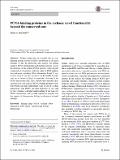Files in this item
PCNA-binding proteins in the archaea : novel functionality beyond the conserved core
Item metadata
| dc.contributor.author | MacNeill, Stuart Andrew | |
| dc.date.accessioned | 2016-03-09T13:10:06Z | |
| dc.date.available | 2016-03-09T13:10:06Z | |
| dc.date.issued | 2016-08 | |
| dc.identifier | 240869819 | |
| dc.identifier | 47ec6f1a-03a1-465b-98d8-ba3bde5a5320 | |
| dc.identifier | 84958762885 | |
| dc.identifier | 000379183500010 | |
| dc.identifier.citation | MacNeill , S A 2016 , ' PCNA-binding proteins in the archaea : novel functionality beyond the conserved core ' , Current Genetics , vol. 62 , no. 3 , pp. 527-532 . https://doi.org/10.1007/s00294-016-0577-3 | en |
| dc.identifier.issn | 0172-8083 | |
| dc.identifier.uri | https://hdl.handle.net/10023/8389 | |
| dc.description.abstract | Sliding clamps play an essential role in coordinating protein activity in DNA metabolism in all three domains of life. In eukaryotes and archaea the sliding clamp is PCNA (proliferating cell nuclear antigen). Across the diversity of the archaea PCNA interacts with a highly conserved set of proteins with key roles in DNA replication and repair, including DNA polymerases B and D, replication factor C, the Fen1 nuclease and RNAseH2, but this core set of factors is likely to represent a fraction of the PCNA interactome only. Here I review three recently characterised non-core archaeal PCNA binding proteins NusS, NreA/NreB and TIP, highlighting what is known of their interactions with PCNA and their functions in vivo and in vitro. Gaining a detailed understanding of the non-core PCNA interactome will provide significant insights into key aspects of chromosome biology in divergent archaeal lineages. | |
| dc.format.extent | 6 | |
| dc.format.extent | 1441323 | |
| dc.language.iso | eng | |
| dc.relation.ispartof | Current Genetics | en |
| dc.subject | Sliding clamp | en |
| dc.subject | Interactome | en |
| dc.subject | Chromosome biology | en |
| dc.subject | DNA repair | en |
| dc.subject | DNA replication | en |
| dc.subject | Archaea | en |
| dc.subject | PCNA | en |
| dc.subject | QH426 Genetics | en |
| dc.subject | Biochemistry, Genetics and Molecular Biology(all) | en |
| dc.subject.lcc | QH426 | en |
| dc.title | PCNA-binding proteins in the archaea : novel functionality beyond the conserved core | en |
| dc.type | Journal item | en |
| dc.contributor.institution | University of St Andrews. School of Biology | en |
| dc.contributor.institution | University of St Andrews. Biomedical Sciences Research Complex | en |
| dc.identifier.doi | https://doi.org/10.1007/s00294-016-0577-3 | |
| dc.description.status | Peer reviewed | en |
This item appears in the following Collection(s)
Items in the St Andrews Research Repository are protected by copyright, with all rights reserved, unless otherwise indicated.

